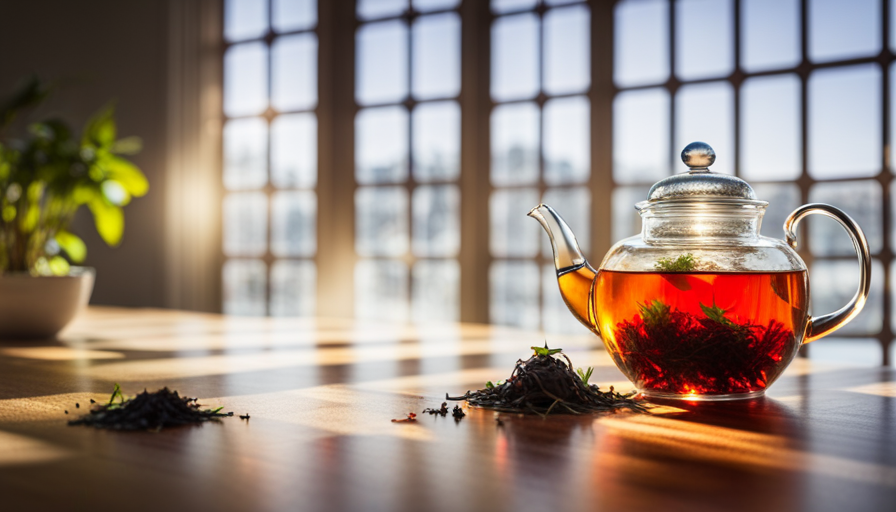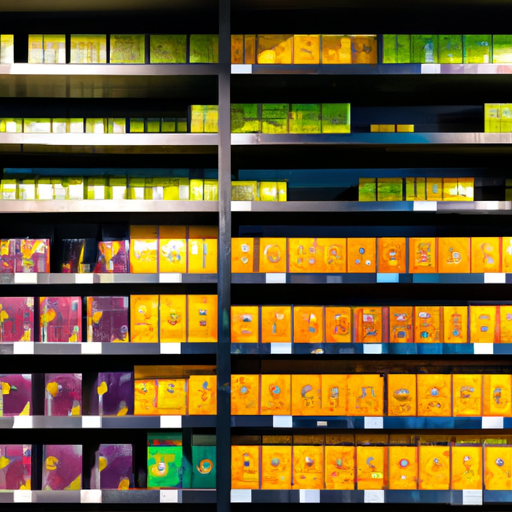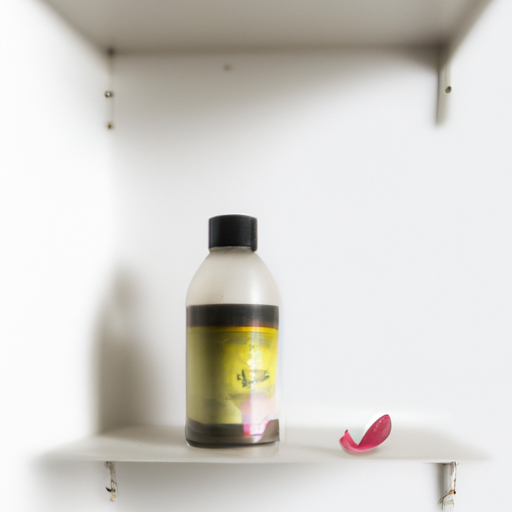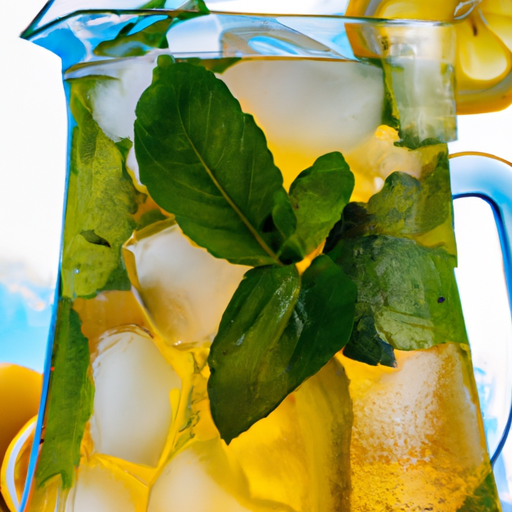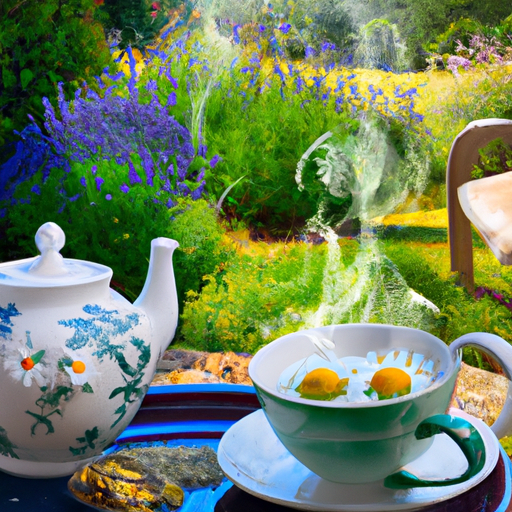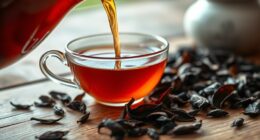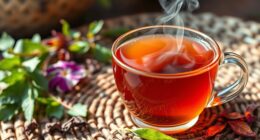Ever thought about how long you should steep your herbal tea for?
Steeping is like a delicate dance between time and flavor, where the essence of the herbs is released into the water, creating a delightful infusion. Just like a symphony conductor, knowing when to stop the steeping process is crucial to achieving the perfect cup of herbal tea.
In this article, I will guide you through the art of steeping various herbal teas, from the soothing chamomile to the invigorating ginger. Each herb has its own unique characteristics, and understanding their ideal steeping times will help you unlock their full potential.
So, grab your favorite mug and let’s dive into the world of herbal tea steeping. Whether you’re in need of relaxation, a burst of freshness, or a spicy kick, these tips and techniques will ensure that every sip is a blissful experience.
Get ready to embark on a flavorful journey with your cup of herbal tea!
Key Takeaways
- Steeping time for herbal tea can vary depending on the herb, ranging from 5 to 15 minutes.
- Adjusting the steeping time can result in a milder or more intense flavor.
- Keeping a journal of herb, steeping time, and personal preferences helps create the perfect cup of herbal tea.
- Pairing herbs with complementary flavors enhances the overall taste of the tea.
Understanding Steeping Time
Now, let’s talk about how long you should let your herbal tea steep. The steeping time for herbal tea can vary depending on the type of tea and personal preference.
It’s important to understand that different tea blends have different benefits, so the steeping time can affect the flavor and the potential health benefits you can derive from your cup of tea.
To choose the right herbal tea, you should consider the ingredients and their properties. For example, if you’re looking for a calming tea, chamomile or lavender blends are great choices. On the other hand, if you’re seeking an energizing boost, go for blends with herbs like peppermint or ginger.
Now, let’s delve into the steeping tips for chamomile tea, which is known for its relaxing properties. To brew a perfect cup, start by heating water to about 200°F. Then, place a chamomile tea bag or loose leaves in a cup and pour the hot water over them. Let it steep for about 5-7 minutes, allowing the flavors to fully develop. Remember, steeping for too long can result in a bitter taste, so it’s important to find the right balance.
Transitioning into the subsequent section about chamomile tea, it’s important to know the tips for a relaxing brew without compromising its flavor.
Chamomile Tea: Steeping Tips for a Relaxing Brew
First, let me tell you, friend, the proper way to infuse that calming chamomile concoction for maximum relaxation. When it comes to chamomile tea, steeping duration is key. To achieve the perfect cup of chamomile tea, you should steep it for about 5-10 minutes. This allows the chamomile flowers to release their soothing properties and flavors into the water. But remember, steeping it for too long can result in a bitter taste, so be mindful of the time.
Chamomile tea is known for its numerous health benefits. It has been used for centuries as a natural remedy for various ailments, including insomnia, anxiety, and digestive issues. The tea contains compounds like apigenin, which promote relaxation and sleep. Chamomile tea also has anti-inflammatory properties and can help ease muscle tension and menstrual cramps. So, not only does it taste delicious, but it also provides a range of wellness benefits.
Incorporating chamomile tea into your daily routine can bring a sense of calm and tranquility. So, take a moment to sip on a warm cup of chamomile tea, allowing its gentle aroma and delicate flavor to wash away the stresses of the day. Next, let’s explore the perfect steeping time for peppermint tea.
Peppermint Tea: Finding the Perfect Steeping Time
To find the ideal infusion time for your peppermint tea, all you need to do is let the refreshing leaves dance in hot water until their invigorating essence has fully bloomed.
When it comes to finding the best peppermint tea brand, there are a few factors to consider. Look for brands that source their peppermint leaves from reputable suppliers and prioritize organic cultivation methods. This ensures that you’re getting the highest quality tea with the most potent flavor.
Drinking peppermint tea offers numerous benefits for both your body and mind. Peppermint has been known to aid digestion and relieve stomach discomfort. It can also help alleviate headaches and reduce stress, making it the perfect drink to unwind after a long day. Additionally, peppermint tea is caffeine-free, making it a great alternative for those looking to reduce their caffeine intake.
Now, let’s transition into the next section about green tea steeping techniques for optimal flavor. Green tea is known for its delicate and nuanced flavors, and getting the steeping technique right is crucial to unlocking its full potential.
Green Tea: Steeping Techniques for Optimal Flavor
Discover the secrets to unlocking the full potential of your green tea by mastering the art of steeping for optimal flavor. When it comes to green tea, the steeping technique is crucial to achieving the perfect taste. Here are three essential techniques to enhance the flavor of your green tea:
-
Water temperature: Use water that’s heated to around 175°F (80°C) to prevent the tea from becoming bitter. Boiling water can scorch the delicate leaves and result in a harsh taste.
-
Steeping time: Green tea leaves should be steeped for about 2-3 minutes. Steeping for too long can make the tea taste bitter, while steeping for too short a time may result in a weak flavor.
-
Tea to water ratio: Aim for 1 teaspoon of green tea leaves per 8 ounces of water. Adjust the amount based on your personal preference for a stronger or milder flavor.
By following these steeping techniques, you can ensure that your green tea is bursting with its natural, fresh flavor.
As we move on to discussing hibiscus tea and unlocking its vibrant flavors, let’s explore how the steeping process plays a crucial role in bringing out the best taste.
Hibiscus Tea: Unlocking the Vibrant Flavors
Immerse yourself in the vibrant flavors of hibiscus tea, where the steeping technique unveils its tantalizing taste, like a symphony of petals unfolding in your cup.
Hibiscus tea is known for its bright red hue and its tart, tangy flavor that’s reminiscent of cranberries. To unlock the full range of flavors, it’s important to use the right brewing techniques.
Start by bringing water to a boil and then let it cool for a minute or two. This’ll ensure that the water is at the optimal temperature, around 195 to 205 degrees Fahrenheit.
Next, add the hibiscus tea leaves or tea bags to a teapot or cup. Use about one teaspoon of loose leaves or one tea bag for every eight ounces of water. Pour the hot water over the leaves and let it steep for five to seven minutes.
During this time, the vibrant red color of the hibiscus petals will infuse into the water, creating a visually stunning brew. Be sure not to steep for too long, as this can result in a bitter taste.
Once the steeping time is up, remove the tea leaves or tea bags and enjoy the tantalizing flavors of hibiscus tea.
Transitioning into the subsequent section about rooibos tea: steeping recommendations for a soothing cup, it’s time to explore another herbal tea that offers a completely different experience.
Rooibos Tea: Steeping Recommendations for a Soothing Cup
As you delve into the world of rooibos tea, prepare for a soothing cup that’ll transport you to a serene oasis of relaxation and tranquility. Rooibos tea, also known as red bush tea, is a herbal infusion that originates from South Africa. It offers numerous benefits, making it a delightful addition to any tea collection.
Here are three reasons why rooibos tea’s worth steeping:
-
Rooibos tea benefits: This tea’s packed with antioxidants, which can help boost your immune system and protect your cells from damage. It’s also caffeine-free, making it a great choice for those looking to reduce their caffeine intake. Additionally, rooibos tea contains minerals like calcium, magnesium, and potassium, which contribute to overall health.
-
Different rooibos tea flavors: Rooibos tea comes in a variety of flavors, allowing you to explore and discover your favorites. From classic rooibos with its earthy and sweet notes to fruity blends like peach or berry, there’s a flavor for every palate. You can even find spiced rooibos teas with hints of cinnamon, vanilla, or caramel.
-
Steeping recommendations for a soothing cup: To achieve the perfect cup of rooibos tea, steep it for around 5-7 minutes in freshly boiled water. This’ll allow the tea leaves to release their flavors and aromas fully. However, remember that personal preferences may vary, so feel free to adjust the steeping time to suit your taste.
Transitioning to the subsequent section about ginger tea: steeping guidelines for a spicy kick, let’s explore another herbal tea that can awaken your senses.
Ginger Tea: Steeping Guidelines for a Spicy Kick
Get ready to awaken your taste buds with ginger tea, as it adds a spicy kick to your tea collection. Ginger tea isn’t just delicious, but it also offers numerous health benefits. The main active compound in ginger, called gingerol, has powerful anti-inflammatory and antioxidant properties. This makes ginger tea a great choice for boosting your immune system, relieving digestive issues, and reducing inflammation in the body.
There are different types of ginger tea that you can try. One popular option is fresh ginger tea, where you steep freshly grated ginger in hot water. This method allows you to fully experience the intense and spicy flavor of ginger. Another option is dried ginger tea, which is made by steeping dried ginger root in hot water. This version has a more subtle and mellow taste compared to fresh ginger tea.
Incorporating ginger tea into your daily routine can provide numerous benefits for your overall well-being. It can help relieve nausea, improve digestion, and even reduce muscle pain and soreness. So why not give ginger tea a try and experience its spicy kick for yourself?
Now, let’s move on to lavender tea and explore the steeping methods for a calming experience.
Lavender Tea: Steeping Methods for a Calming Experience
To create a calming experience, try steeping lavender tea using different methods and savor the soothing effects it brings.
Lavender tea is known for its relaxation properties and delicate floral aroma. When steeping lavender tea, the duration is crucial to achieve the desired flavor and benefits. Generally, it’s recommended to steep lavender tea for about 5-7 minutes. This allows the tea leaves to release their essential oils and infuse the water with their calming essence.
Steeping lavender tea for too long can result in a bitter taste, so it’s important to monitor the time carefully. However, if you prefer a stronger flavor, you can steep it for up to 10 minutes. On the other hand, if you prefer a lighter taste, steeping for 3-4 minutes should be sufficient. Experimenting with different steeping durations will help you find the perfect balance that suits your taste preferences.
In addition to its delightful taste, lavender tea offers numerous health benefits. It’s known to promote relaxation, reduce anxiety, and improve sleep quality. It can also aid in digestion and help relieve headaches. By incorporating lavender tea into your daily routine, you can experience its calming effects and enhance your overall well-being.
When it comes to experimenting with steeping times, there are a few tips to keep in mind. Stay within the recommended time frames to avoid bitterness, but feel free to adjust the duration slightly to find your ideal taste. Remember, each person’s preference may vary, so don’t be afraid to try different steeping methods and durations until you find the one that brings you the most tranquility.
Tips for Experimenting with Steeping Times
When it comes to herbal tea, there are endless possibilities to explore. In my previous subtopic, I discussed the calming effects of lavender tea and the different methods to steep it for a soothing experience. Now, let’s dive into the exciting world of experimenting with steeping times for various herbs.
-
Start with the basics: Each herb has its own optimal steeping time, which can range from 5 to 15 minutes. It’s essential to follow the recommended time to extract the best flavor and benefits.
-
Short and sweet: If you prefer a milder flavor, try reducing the steeping time. This can be particularly useful when working with strong herbs like peppermint or ginger.
-
Long and strong: On the other hand, if you want a more intense flavor, consider extending the steeping time. Herbs like chamomile or hibiscus can benefit from a longer infusion.
-
Keep a journal: To truly master the art of steeping, keep track of your experiments. Note down the herb, steeping time, and your personal preferences. This’ll help you create your own perfect cup of herbal tea.
Now that we’ve explored the best practices for steeping, let’s move on to the next section and discover how to truly enjoy the perfect cup of herbal tea.
Enjoying the Perfect Cup of Herbal Tea
Savoring the ideal cup of herbal tea is an exquisite experience that transports me to a world of relaxation and indulgence. Understanding flavor profiles is the key to unlocking the perfect cup of herbal tea.
Each herb has its own unique taste and aroma, and knowing how to pair them can enhance the overall flavor of the tea. For example, chamomile has a delicate and floral taste, while peppermint offers a refreshing and minty flavor. By experimenting with different combinations, I can create a personalized blend that suits my taste preferences.
Aside from the delightful taste, herbal tea also offers numerous health benefits. Many herbs are known for their therapeutic properties, such as calming anxiety, aiding digestion, or boosting the immune system. By incorporating herbal tea into my daily routine, I can reap these benefits and promote overall well-being.
To enjoy the perfect cup of herbal tea, I follow a few simple steps. First, I bring water to a gentle boil and then pour it over the tea leaves or tea bag. I let it steep for about 5-10 minutes to allow the flavors to infuse into the water. Finally, I strain the tea and savor each sip, allowing the aromatic blend to soothe my senses.
Understanding flavor profiles and the benefits of herbal tea enhances my tea-drinking experience. By experimenting with different combinations and taking the time to savor each cup, I can indulge in a moment of relaxation and reap the medicinal benefits that herbal tea offers.
Frequently Asked Questions
Can I reuse the tea leaves or bags for multiple steepings?
Reusing tea leaves or bags for multiple steepings can have several benefits. It’s like squeezing every last drop of goodness from a lemon. By reusing the tea leaves, you can extract more flavor and nutrients, making each cup even more enjoyable.
Plus, it’s an economical choice that reduces waste. Just remember to adjust the steeping time for subsequent brews to avoid any bitterness.
So go ahead, get the most out of your tea leaves and savor the benefits of multiple steepings.
What is the difference between steeping herbal tea in a teapot and using a tea infuser?
When comparing steeping herbal tea in a teapot versus using a tea infuser, there are distinct benefits and advantages to consider.
Using a teapot allows for a larger quantity of tea to be brewed at once, making it ideal for serving multiple cups. Additionally, the teapot’s larger size allows the tea leaves more room to infuse and develop their flavors.
On the other hand, a tea infuser offers the convenience of individual servings and is easily portable, making it great for on-the-go tea enthusiasts.
Can I add sweeteners like honey or sugar while steeping herbal tea?
Of course, the age-old debate of whether or not to add sweeteners to herbal tea while steeping. Ah, the eternal quest for the perfect balance of flavors.
Now, let’s delve into the pros and cons of using different sweeteners in herbal tea. Honey, with its natural sweetness and subtle floral notes, can enhance the flavors without overpowering them. On the other hand, sugar can provide a straightforward sweetness but may mask some of the delicate herbal nuances.
It all boils down to personal preference, so experiment and find your blissful brew!
How long should I wait before removing the tea leaves or bags from my cup?
To enhance the flavor of herbal tea, I recommend steeping it for 5-7 minutes. This allows the tea leaves or bags to release their full flavor and aroma. Adding sweeteners like honey or sugar during the steeping process can also enhance the taste.
Furthermore, drinking herbal tea before bedtime offers numerous benefits. It can help relax the mind and body, promote better sleep, and even aid digestion. So, enjoy a cup of properly steeped herbal tea and reap its soothing effects before bedtime.
Are there any specific temperature recommendations for steeping herbal tea?
There are specific temperature recommendations for steeping herbal tea. The optimal temperature can vary depending on the type of herbal tea you’re brewing. Generally, it’s recommended to bring the water to a boil and then let it cool for a few minutes before pouring it over the tea leaves or bags. This helps to preserve the delicate flavors and beneficial compounds found in herbal tea.
Enjoying herbal tea at the right temperature maximizes its soothing and health-promoting benefits.
Conclusion
As I conclude this journey through the art of steeping herbal tea, I’m reminded of a beautiful garden. Each cup of tea is like a delicate flower, waiting to bloom and release its unique flavors and aromas.
Just as a gardener tends to their plants with care and precision, so must we approach the steeping process. By understanding the optimal steeping times for different herbal teas, we can unlock their true potential and create a truly delightful experience.
So, my dear tea enthusiasts, embrace the art of steeping and savor every sip of your perfectly brewed cup of herbal tea.

